With 19 games played so far in the Bundesliga, RB Leipzig sit one point clear at the top of the table. Closely behind them, snapping at their heels, are a resurgent in-form Bayern Munich, surprise contenders Borussia Mönchengladbach, and a Borussia Dortmund side who aren’t short of goals or confidence. Between them all there are just four points, and after Leipzig lost to Eintracht Frankfurt last weekend, the leaders now sit just one point ahead of reigning champions Bayern. With the gap being so close, Leipzig haven’t looked to just stick with the squad they have, instead, they have brought in one of the most sought after midfield talents on the continent.
Dani Olmo starred for Spain in the European U21 championship-winning side, and continued to excel at Dinamo Zagreb, a club he had been with since he was 15 years old, for the first half of the season scoring eight goals and registering six assists in all competitions. He is joining Leipzig for a fee of £18 million, according to Transfermarkt, which is seemingly a bargain, seeing as the same website values him at £31.5 million.
This scout report and tactical analysis will give an analysis of how Olmo will fit into Leizpig’s system, and what he will bring to the side as Leipzig seek to win their first Bundesliga title.
Where he will play
One of the reasons that not just Leipzig, but the Red Bull organization as a whole has been so successful, is that they recruit based on their over-arching philosophy of fast-paced high-intensity football, with an emphasis on playing forward quickly and purposefully with a robust pressing system. Across the board, they recruit players that will fit well into their tactics, and are generally able to integrate players into the side and have them contribute quickly. In their starting XI against Eintracht Frankfurt, five of their players had joined within the last 18 months, in the form of Nordi Mukiele, Amadou Haidara, Tyler Adams, Christopher Nkunku, and Patrik Schick. On the bench as well were Ademola Lookman, Hannes Wolf, and Ethan Ampadu who had all joined them in the same time period, whether permanently or on loan. On top of this, Konrad Laimer, who started in central midfield, and back up goalkeeper Yvon Mvogo both joined them the season before any of the aforementioned players had come in. So this isn’t a side that has been together for a long time.
For us to see where Olmo fits into the RB Leipzig side it is pertinent to look at how Leipzig have set up under Head Coach Julian Nagelsmann, and the types of players he has been using in positions where Olmo may well feature.
Left attacking midfield/ Left-wing
Firstly, it should be noted that Nagelsmann is tactically versatile, and is flexible with how he has his team line up. Nevertheless, he generally prefers to use four at the back, and a 4-2-2-2 has been frequently used in recent months, as well as a 4-2-3-1. He isn’t afraid of playing three at the back though, as he did so against Eintracht Frankfurt, and has favoured a 3-5-2 or a 3-4-2-1 when doing so.
At Dinamo Zagreb, Olmo was most often played as part of a central-midfield pair, anchored by a single pivot, however, he also featured in the ten role, or on either side of an attacking front three. His heat map from this season shows how he isn’t limited to one role.
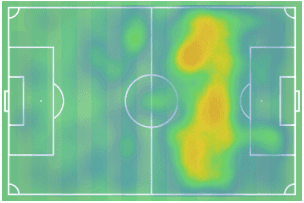
Due to Nagelsmann’s penchant for using a double pivot in central midfield, Olmo will most likely find himself being used as a left-attacking midfielder or as a number ten, as it would be a waste of Olmo’s creative capabilities to play him in a deeper role.
Playing on the left flank as a winger or attacking midfielder, he is going to face competition from Nkunku and Emil Forsberg.
The signing of Olmo may be tough for Forsberg to take, as it could well push him even further down the pecking order.
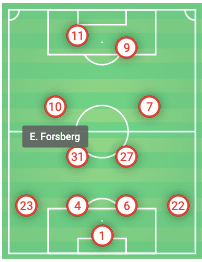
Forsberg is a shadow of the player he was in the 2016/17 season where he scored eight goals and made an incredible 18 assists. Forsberg has managed just 12 assists cumulatively over the successive two and a half seasons since that impressive campaign. In all competitions this season he has eight goals and three assists in 20 games. That doesn’t sound too bad, however, only three of these goals have come from open play and even then, one was courtesy of a howler of the highest order from Bayern-bound Schalke goalkeeper Alexander Nübel.
Last season he managed six goals and six assists in 24 games in all competitions, however, again only three goals came from open play.
The type of graph below will be used frequently throughout this article to highlight the positives and shortcomings of individual players. It’s clear from this graph that Poulsen may not dribble a huge amount (D/90) but has a high success rate from when he does choose to engage in a 1v1 situation (DR%). He also has a high goal per 90 (G/90) and goal conversion percentage (GC%), however, that will be partly down to his penalty-taking duties. He doesn’t get a great deal of shots away per 90 (S/90).
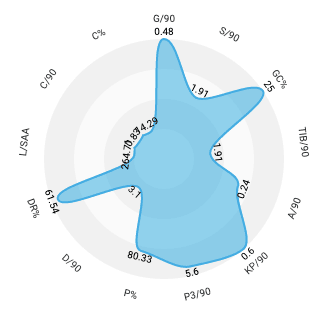
Forsberg is a good squad player but may get frustrated with a lack of first-team football and look elsewhere. Olmo is an upgrade on him, but if Forsberg does stay, then it just adds to the strength in depth this side already has.
I believe this will be Olmo’s most effective position despite the fact he has predominantly played as a central midfielder this season.
Operating in a wider position he is naturally going to get more time and space on the ball. Olmo is incredibly good in 1v1 situations and likes to get isolated against defenders in such situations, however, it is not uncommon to see him calmly manoeuvre his way past two or three players who are tightly grouped around him. He is excellent at drawing defenders to him when in possession, and he will no doubt create holes in opposition defences for Werner to run into.
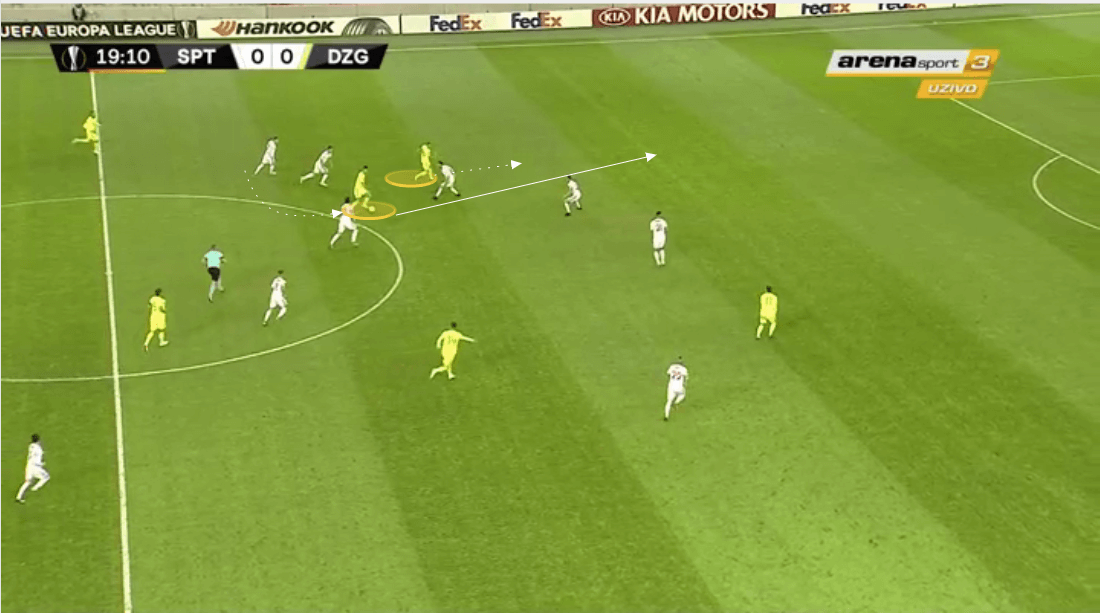
This season he has averaged a 49.4% completion on his 8.8 dribbles per game and only Josip Mitrović of Inter Zaprešić has attempted more dribbles per game than him. He is very comfortable in the final third and has a natural ability to make things happen, whether through an incisive pass or running at defenders. This season he has won 40.2% of his 14.8 offensive duels per game. He has also managed 3.49 deep completions per game in the Croatian 1. HNL, again the second most in the entire league.
On top of all of his attacking traits, Olmo is a hard-worker and very quick. It’s no secret that Nagelsmann favours an intense press, and Olmo will fit in perfectly as part of this system. He has demonstrated this for Dinamo this season, pressing well with 59% of his 5.44 ball recoveries per game coming inside the opposition half.
Should Nagelsmann want to play a similar formation to the 3-4-2-1 he used against Frankfurt, Olmo has plenty of experience playing as part of a front three too, and if he wasn’t used in central-midfield by Dinamo, he was often played in the same role that Amadou Haidara occupied last weekend.
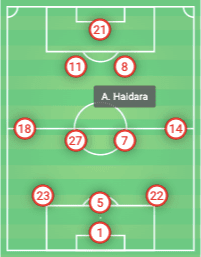
Playing through the middle
Should he be used in the position he most commonly filled for Dinamo, it would likely be as part of a 3-5-2, like Nagelsmann used against Benfica in this season’s Champions League. Again this is a position Forsberg has played in, although Kevin Kampl has also been used in this position too this season. When playing for Dinamo, Olmo is often the most expansive of the midfield three and would be given a fair amount of freedom to push forward and link up with the front two.
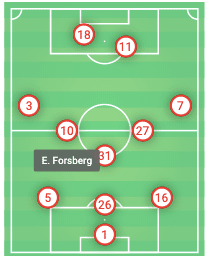
However, Nagelsmann hasn’t made a habit of using this formation and if we are to see Olmo play in the middle it is likely to be as a number ten. In this position, Leipzig frequently use Nkunku or Yussuf Poulsen, although the likes of Werner, Forsberg and Marcel Sabitzer have also been used in such a role.
Nkunku has adapted well to life in Germany and has played his way into featuring regularly for the league leaders. However, like Forsberg, he also has a right to be concerned over the impact that Olmo would have on him seeing regular minutes.
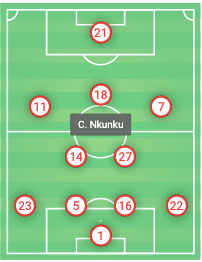
Nkunku ranks joint fourth in the league for assists with six, along with the likes of Filip Kostić, Serge Gnabry, and teammate Werner, and behind only Thorgan Hazard, Thomas Müller and of course, Jadon Sancho. He has also notched three goals to boot too.
So far this season Nkunku has played as a left-winger, right-winger, centre-forward, central-attacking midfielder, centre-midfielder, and as a left wing-back. His versatility has made him a vital part of the core of this side, and versatility is a quality that is shared by Leipzig’s new signing Olmo. Nkunku’s ability to play well in a variety of positions means he should still get regular game time, even if Olmo does pinch his position.
The image below shows that Nkunku rates highlight for key passes per 90 (KP/90) and assists per 90 (A/90) but isn’t as strong a dribbler as Forsberg despite taking almost twice as many dribbles as his teammate, and is weaker in both dribbling categories than Olmo. He is perhaps a little goal shy with an average score on both shots per 90 and goals per 90, which is disappointing bearing in mind he manages 3.85 touches in the box per game (TIB/90). However, arguably the most disappointing statistic is his goal conversion percentage which is just 10.71%.
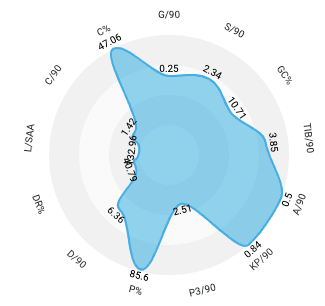
Poulsen also played in a string of games playing as a ten, however, Olmo is far more of an orthodox number ten than him. Whereas Olmo is as much of an archetypal creator as he is a goal threat himself, Poulsen played more so as a second striker in a slightly deeper role, looking to get knockdowns for Werner, holding up play, supporting Werner in more of a traditional striker role, and working as the second line of the press. So to compare Poulsen to the other players would be a little misleading.
This signing suggests Poulsen will see fewer minutes in this position, and seeing as he has only started 50% of games, Poulsen may have to accept his role as back-up forward, particularly with Patrik Schick hitting four goals in nine league games so far.
Marcel Sabitzer has been outstanding this season and is a cornerstone of this side. Timo Werner has rightly been receiving plenty of plaudits for his performances this season, however, Sabitzer has been impressive in his own right and has registered 12 goals and seven assists in all competitions for Leipzig. He has been used in the ten role at times this season, however, the transfer of Olmo indicates Sabitzer will most likely play as a right-winger or right-sided attacking-midfielder almost exclusively going forward.
The image below shows Sabitzer excels in passes into the final third per 90 with 6.16 as well as key passes per 90 with 0.74.
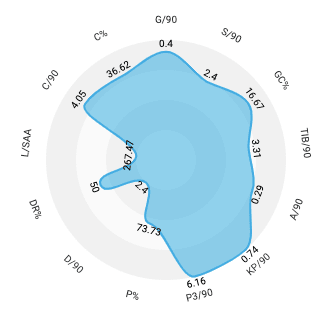
Olmo would be an excellent option for Nagelsmann in this position due to his creativity on the ball in central areas.
One of Olmo’s biggest strengths lies in his ability as a passer of the ball. He plays twice as many passes forward per game as he does backwards passes, and for a coach such as Nagelsmann who values vertical passing almost more than anything else, this is an important quality. He averages 77% on both forward passes and passes into the final third, as well as an overall 82% pass completion.
He has a terrific range of passing too, and he isn’t just someone who can play tidy passes to split open defences. He is brave on the ball, can switch play in an instant, and weight passes perfectly to drop over the top of full-backs in order to release wide players.
The image below shows him drawing in three defenders as Shakhtar Donetsk’s defence becomes narrower. He cuts back on himself as he spreads a perfect pass over the full-back for his right-winger to move onto.
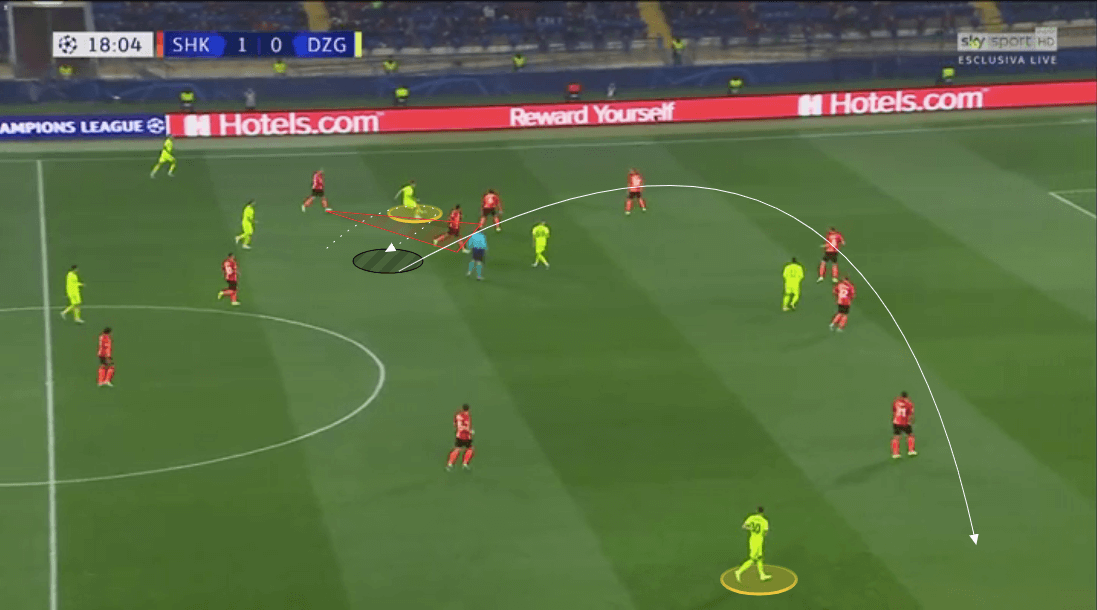
Olmo isn’t just a flair player either. Earlier I mentioned his commitment to the press, which will obviously serve him well at Leipzig, and he is combative in the middle of the pitch too, winning 64.1% of his 4.76 defensive duels per game too.
Finally, his movement off the ball is exceptional, and from an advanced position in midfield, he will cause defenders problems. He likes to push high and occupy the final line of defence. From here he can move in behind, as we can see him doing for Spain’s under 21’s in the image below.
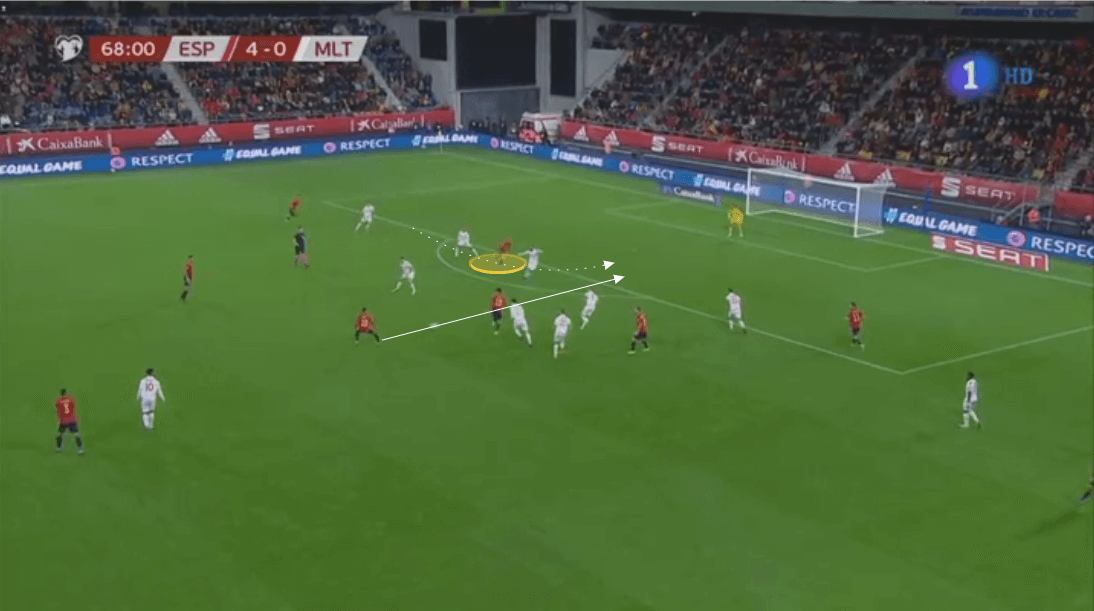
To think he is just a creator who will pull strings from midfield is wrong. He gets forward and gets into good positions inside the box to either shoot or assist. He has averaged 3.49 touches in the box per game this season which is a lot for someone who predominantly plays in centre-midfield.
At the same time, he will also drop a little deeper and look to receive the ball in between the lines, as the image below shows him doing.
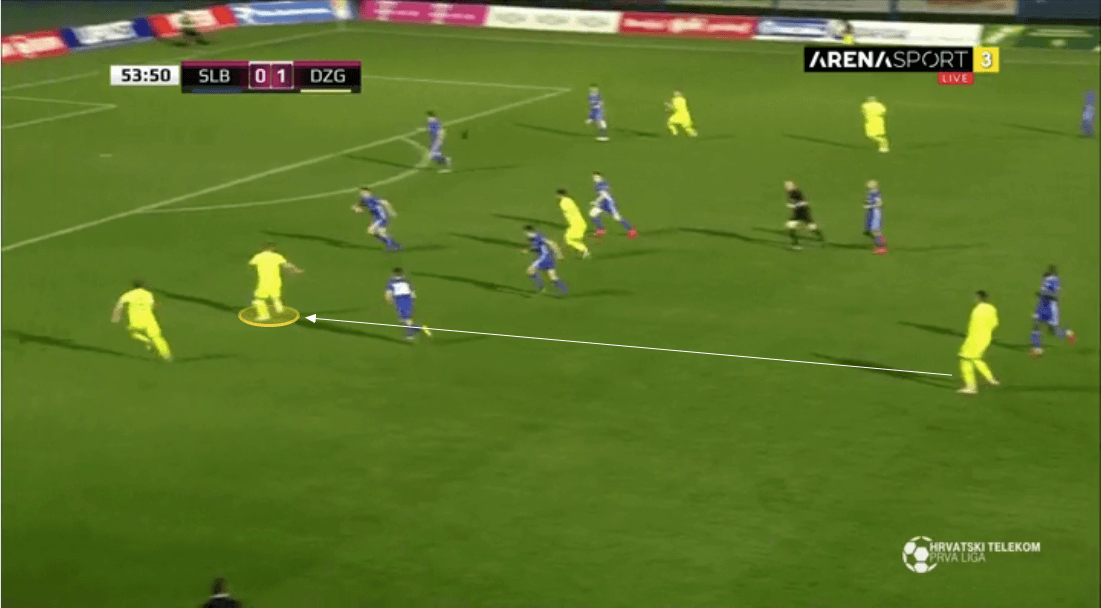
Olmo isn’t afraid to shoot and if given space whether that’s inside or outside the area, he will pull the trigger, as his shot map is testament to. He averages 3.1 shots per game with a 37% accuracy and has scored goals from all parts of the pitch this season.
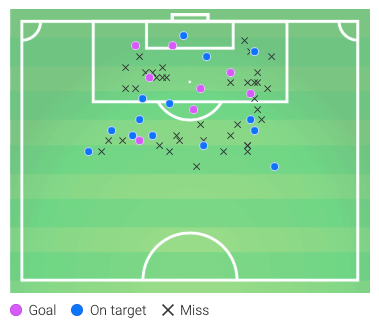
I have already discussed his passing ability, however, it truly is at its best when he has time to play in between the lines in a ten position. Olmo is excellent at spotting the gap in defence and playing a pass perfectly to meet the timed run of one of his forwards. Nagelsmann will surely be excited to link him together with Werner. He is a strong provider and will only improve and, if he continues averaging close to his current 1.66 shot assists per game this season, he will no doubt quickly increase his assists tally for the year.
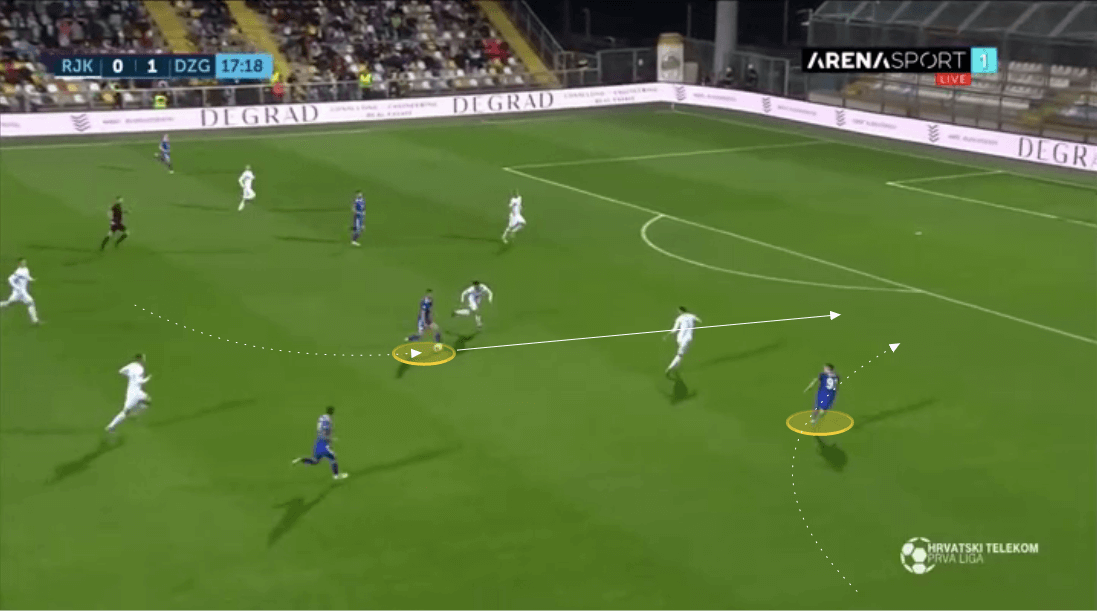
The difficulty with threading passes through such small gaps is ensuring the defence don’t read the pass, and he is able to disguise them well through body shape or by playing the pass in a different direction to where he is looking.
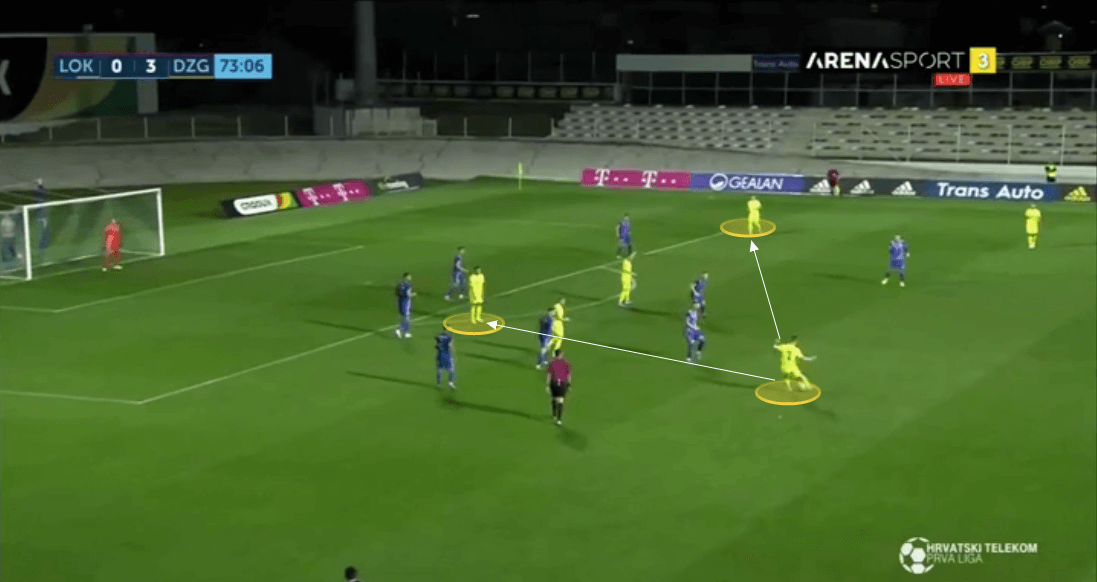
He has a wonderful ability to cut across from the left-side and operate in central areas and again will look to play through the gaps in the backline. What is noticeable from these areas is how flat his passes can be, sometimes with no angle at all. Again it showcases his ability to perfectly weight a through ball.
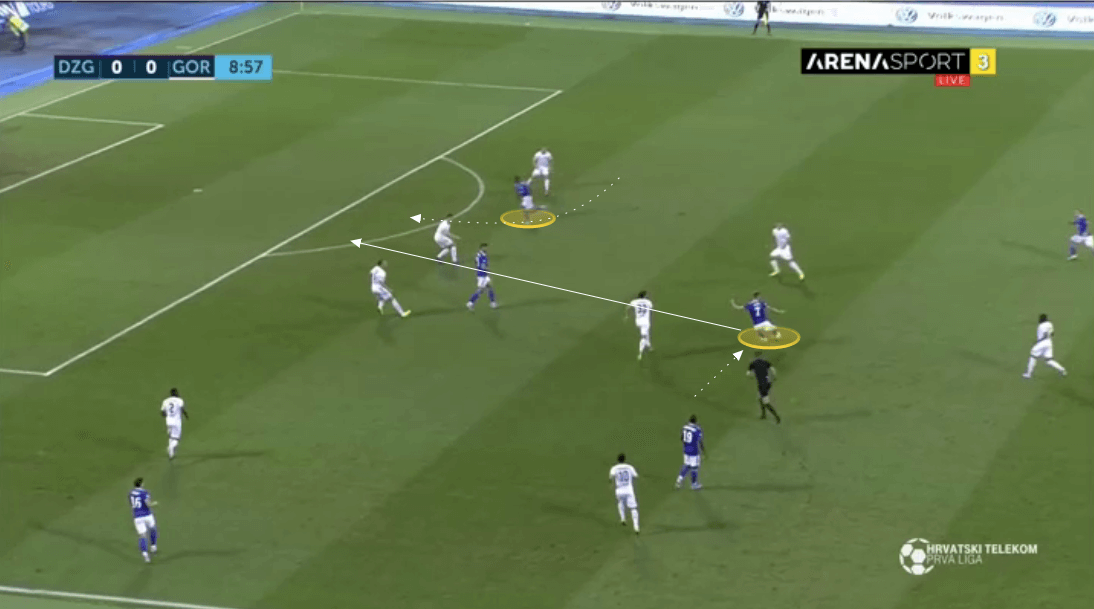
He is truly an all-round outstanding asset to have and as the analysis below shows, he is strong across the board. With his high amounts of shots per 90, touches in the box, and dribbles per 90, he is going to come into this Leipzig side and contribute offensively immediately.
The graph below of his statistics from the league this year shows he is almost a culmination of many of the outstanding qualities of the attacking players he will be joining. He has excellent passing, with a strong amount into the final third per 90, like Sabitzer, as well as his overall passing percentage; his dribbling is exceptional both in amount per game and completion, with more dribbles than Nkunku and far more than Forsberg, whilst only a slightly lower completion percentage than Forsberg. He gets plenty of touches in the box as well as a good amount of shots on goal per 90. His assists per 90 is lower than he would perhaps like, but as I mentioned earlier, when he begins playing behind Werner I’d be willing to wager that will increase quickly.
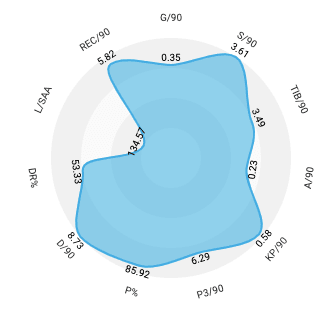
Conclusion
I foresee Olmo playing in a hybrid of a left-attacking midfield role and as a number ten. It is likely Nagelsmann will pursue with the 4-2-2-2 that Leipzig have been so devastating with this season. Olmo is dangerous in wide positions, but will likely be given license to move inside and operate in the middle behind the forwards too. This gives marauding left-back Marcel Halstenberg the freedom to push forward and operate in space, whilst Werner has also been particularly good when playing on the left of the front three as part of a 4-2-3-1. With Olmo moving inside, Werner would still be able to do this as well.
It is yet another example of Red Bull’s excellent scouting network, and their ability to move quickly and bring in-demand players from across the globe into their team’s who have plenty of talent, and plenty of potential to increase in market value. It may just be the singing of the transfer window.





Comments